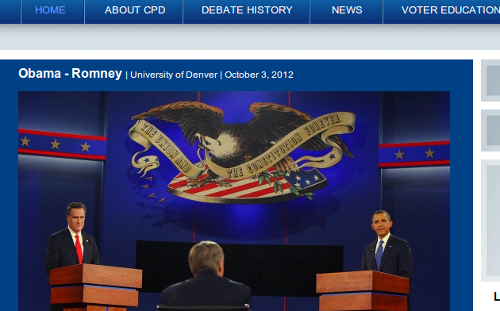
Image Credit: Commission on Presidential Debates
Despite its vaguely governmental-sounding name, the Commission on Presidential Debates is a private, non-profit corporation funded by a handful of businesses, as described by George Farah. The Commission serves to accommodate the Republican and Democratic Parties' desire for a relatively controlled event—control which drove the League of Women Voters to withdraw from hosting the debates in 1987. One of the long-standing contributors to the Commission is the Anheuser-Busch corporation (owned since 2008 by the Brazilian and Belgian conglomerate InBev). While watching the debates, I couldn't help but notice the similarity between the eagle that hangs above the heads of the candidates and the Anheuser-Busch eagle, both of which draw on deeply set US political imagery.
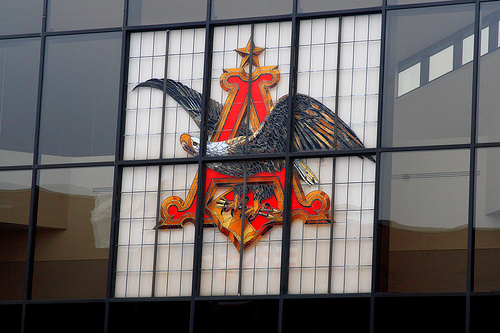
Image Credit: Frank Peters
I'm not suggesting here that the debate eagle is some sort of subliminal advertising for Anhauser-Busch, though the correspondences are remarkable in terms of the eagle's posture. However, these correspondences are likely due more to the larger genre of American bald eagle imagery than an effort to associate the debates with one of America's most sold beers. In the debates the eagle serves as a sort of unofficial official seal when the presidential seal would be inappropriate (as both candidates are, supposedly, equally potential presidents even if one currently holds the office). Slate attempted to track down the origin of the eagle as used by the Commission, and while they located several historical precedents, the Commission gave Slate a rather ambiguous answer that the eagle is "an amalgam based on something they found in the Smithsonian Museum."
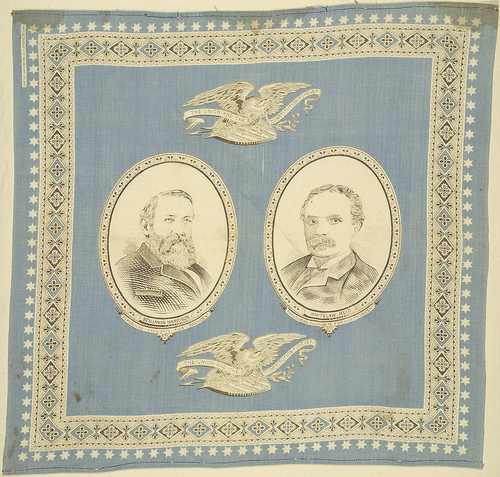
Image Credit: Cornell University Library
As Slate describes, the image of an eagle clutching a banner with the phrase "The Union and the Constitution Forever" can first be seen in a campaign handkerchief from the Garfield-Arthur campaign in 1880 and again in the above campaign handkerchief from the 1892 Harrison-Whitelaw campaign. Note the size differential in the juxtaposition of candidates and eagle. In the nineteenth century images, the candidates faces hold prominence over the smaller eagles, but in the twenty-first century debates, the eagle dwarfs the candidates as if to promote democratic ideals over the identities and politics of the individuals who fleetingly hold office against the background of an eternal Constitution.
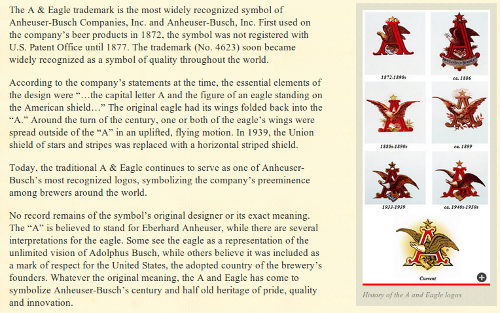
Image Credit: Anheuser-Busch
Like the somewhat ambiguous origins of the debate eagle, the Anheuser-Busch logo has somewhat mysterious origins, as their website explains that "no record remains of the symbol’s original designer or its exact meaning." Anheuser-Busch makes the reasonable speculation that the A in the logo stands for Anheuser and that the eagle may bear some connection to the prominent eagle imagery in US visual rhetoric.
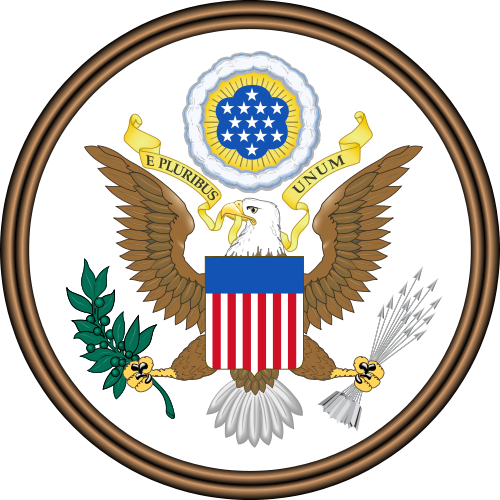
Image Credit: United States Government
As noted in the Slate article, the debate eagle looks away from the olive branches of peace and toward the arrows of war, whereas the eagle in official government seals and even the nineteenth century campaign materials looks toward the olive branches. The Anheuser-Busch eagle only clutches arrows in its claws, but it looks away from the arrowheads (perhaps nodding to the wisdom in refraining from the use of weapons while imbibing while still never letting said weapons out of reach). Both the beer and debate eagles stand on a shield similar to that found in the Great Seal of the United States (though in the Anheuser-Busch logo the top of the shield points at the viewer while in the debate and nineteenth century images the bottom of the shield points at the viewer). And both pose with wings spread as if swooping down from the sky to grab prey or alighting to stand watch—be it over the principles of democracy or of free enterprise.





Recent comments
2 years 29 weeks ago
2 years 44 weeks ago
2 years 44 weeks ago
2 years 50 weeks ago
3 years 4 weeks ago
3 years 4 weeks ago
3 years 4 weeks ago
3 years 6 weeks ago
3 years 6 weeks ago
3 years 6 weeks ago